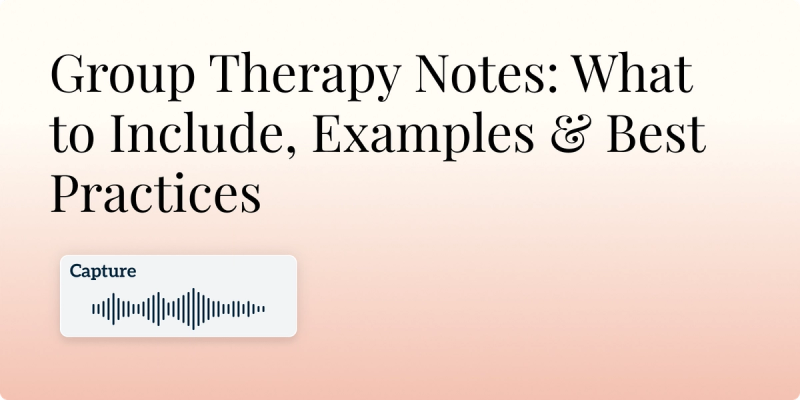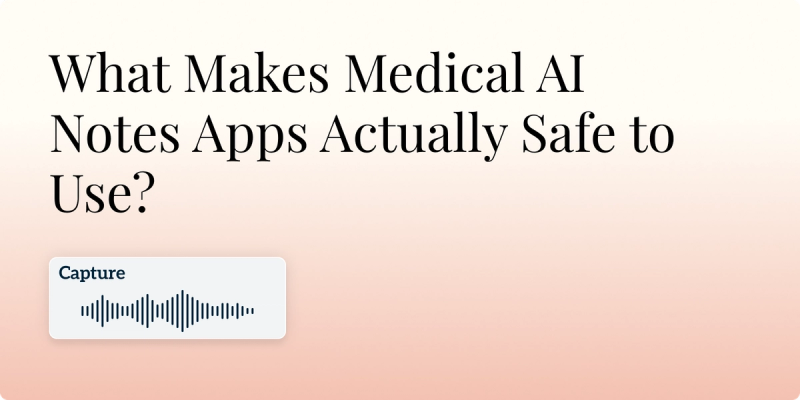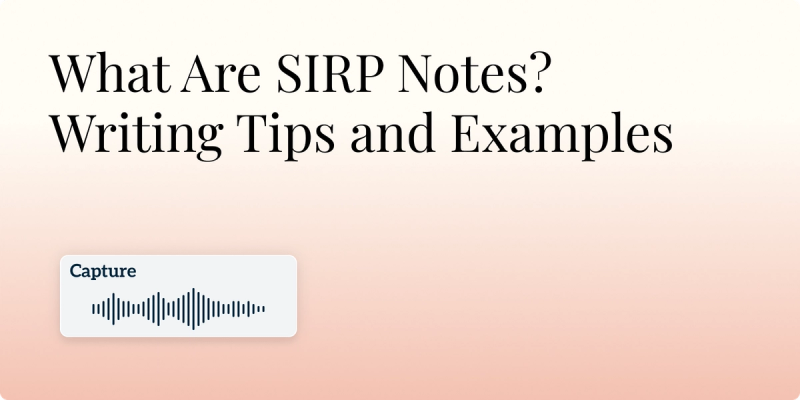
Group Therapy Notes: What to Include, Examples & Best Practices

What Are Group Therapy Notes?
Group therapy notes are the clinical progress notes that memorialize what happened in a group therapy session: who attended, how the group dynamics evolved, which therapeutic interventions were applied, and how each participant moved (or failed to move) toward the goals in their treatment plans.
Because they live in the legal health record, they are discoverable, can be requested by insurers, and must meet the documentation standards of your state licensing board, 42 CFR § 482.24, and any payer contracts you hold. T
These notes differ sharply from psychotherapy notes, which the HIPAA Privacy Rule shields from routine disclosure; psychotherapy notes are your private musings and should be stored separately.
In practice, group therapy notes serve four overlapping purposes:
- Clinical continuity – The next facilitator (or you, months later) can instantly see where each client is in the process.
- Quality improvement – Aggregated notes reveal patterns such as who repeatedly dominates airtime or which skill modules spark the biggest gains.
- Risk management – Good documentation demonstrates adherence to AGPA practice guidelines and can rebut malpractice claims.
- Billing compliance – Payers require proof that the billed CPT code (often 90853) corresponds to medically necessary, skill‑based group psychotherapy.
Because therapy notes also function as teaching tools for interns and interprofessional teams, clarity—free of jargon—matters as much as completeness.
Group Therapy Notes vs Individual Therapy Notes
Individual therapy generates a single‑client narrative that can lean heavily on subjective nuance. Group therapy notes, by contrast, must weave together collective processes—cohesion, conflict, alliances—with concise snapshots of each participant’s behavior. The clinician therefore oscillates between a wide‑angle lens (overall group mood, emergence of norms) and a telephoto lens (Maria’s panic attack at minute 27).
Another practical difference is retention. Under 42 CFR § 482.24, records must be stored ≥ 5 years (many states extend to 7–10 years; minors often until age 23). That clock applies to every member’s progress notes—even if someone drops out early.
Group Therapy Notes | Individual Progress Notes | |
|---|---|---|
Primary focus | Interplay of group dynamics, themes, and each client’s reactions | One‑to‑one therapeutic process |
Scope | Must balance collective events with per‑client observations | Single‑client narrative |
Confidentiality hurdles | Omit identifying data about other members to protect privacy | Freer to reference all session content |
Documentation load | One shared section + tailored addenda for each member | One note per client |
Efficiency tips | Batch templates, speaker tags, AI‑powered scribe | Batch templates, speaker tags, AI‑powered scribe |
Regulatory nuance | Same retention rules; extra attention to informed consent | Standard retention rules |
What to Include in a Group Therapy Note
Think of each group therapy note as the executive summary of a therapy session plus mini‑status reports for each attendee. Here is a deeper dive into every element:
1. Group Details (Date, Time, Modality, Facilitator)
Precise timing demonstrates medical necessity and supports time‑based billing models. Virtual or hybrid sessions should note the HIPAA‑secure platform, any tech disruptions, and whether webcam‑on policies were enforced. This level of specificity answers telehealth auditors’ common question: “How did you confirm active therapeutic interaction for CPT 90853?”
2. Participant Names & Attendance
Attendance is more than a roll call; it contextualizes fluctuations in group dynamics. A chronically absent member can stall exposure hierarchies in an anxiety group or destabilize cohesion in a DBT skills group. Late arrivals or early departures should include reason if known (e.g., “A.G. disconnected twice due to poor Wi‑Fi”).
3. Summary of Session Themes
Spell out the therapeutic curriculum: “Session 7 of Seeking Safety—‘When Substances Control You’ psychoeducation delivered.” Explicitly linking back to manualized models (e.g., TIP 41, SAMHSA) shows reviewers you are applying evidence‑based interventions and not ad‑libbing.
4. Observations on Participation & Engagement
Describe the texture of interaction: turn‑taking, side‑conversations, affect contagion, body language. Empirical work in CBT groups shows that group cohesion and therapeutic alliance predict symptom reduction up to four years post‑treatment—an outcome you can only measure if you actually document these variables.
5. Client Progress Toward Goals
Anchor comments to the individualized objectives in each member’s treatment plan: “Goal 2: Identify three thought distortions per week. Today client identified two in vivo.” When progress stalls, name the barrier (e.g., avoidance, external stressor) and outline an adjustment.
6. Therapist Interventions & Responses
List modality (CBT, EMDR, ACT), technique (Socratic questioning, bilateral stimulation), and client reaction: “Bilateral stimulation tolerated; SUDS 8→4.” Avoid vague verbs like “discussed” or “addressed.”
7. Next Steps or Follow‑Up Plan
Plans might include future sessions (“Introduce crisis‑survival skills next week”), homework, collateral contacts, or safety‑check intervals. Close the loop by referencing prior homework compliance; payers view this as proof of ongoing medical necessity.
Common Group Therapy Note Formats
Different note formats highlight different facets of a group session. Choose the architecture that best aligns with your treatment model and payer expectations.
SOAP Format (Subjective, Objective, Assessment, Plan)
- When to use SOAP format: Integrated medical and behavioral health settings where clinicians share one EHR.
- Deep advantage: The S/O split trains interns to separate perceptions from observable metrics—vital when documenting group dynamics that can be misread.
GIRP Format (Goals, Intervention, Response, Plan)
- When to use GIRP format: Skills‑based programs (DBT, Seeking Safety, psycho‑education groups).
- Deep advantage: Starts with goals, forcing the writer to tether every intervention to an outcome—a favorite with utilization reviewers.
DAP Format (Data, Assessment, Plan)
- When to use DAP format: Community agencies and crisis‑stabilization units where brevity is gold.
- Deep advantage: The “Data” header accommodates both qualitative and quantitative metrics (e.g., “Cohesion index 7/10”).
BIRP Format (Behavior, Intervention, Response, Plan)
- When to use BIRP format: Trauma and SUD groups emphasizing observable coping behaviors.
- Deep advantage: Places behavior first, nudging therapists to stay objective and resist speculation.
Best Practices for Writing Effective Group Therapy Notes
Best Practice | Practical How‑To | Why It Matters |
|---|---|---|
Use Objective, Non‑Judgmental Language | Describe observable behavior: “Client interrupted peers twice” instead of “Client was rude.” | Prevents bias, supports clinical clarity, and withstands legal scrutiny. |
Avoid Duplicating Notes Across Clients | Write one shared header, then add individualized addenda; never copy‑paste identical text. | Upholds individualized care and avoids HIPAA breaches. |
Maintain Confidentiality in Shared Notes | Refer to others with initials or neutral descriptors; omit third‑party diagnoses. | Protects PHI and aligns with HIPAA guidance for group therapy notes. |
Be Brief but Clinically Meaningful | Capture data that affects diagnosis, risk, or treatment progress; skip small talk. | Reduces documentation time while keeping notes audit‑ready. |
Document Only What’s Clinically Relevant | Include session themes, interventions, responses, risk factors, and plan; exclude irrelevant anecdotes. | Keeps progress notes focused and defensible. |
Use Pre‑Built or Customizable Templates | Leverage tools like the mental health group note template. | Ensures consistency, saves time, and minimizes errors. |
Start Notes During or Immediately After the Session | Draft bullet points in‑session or complete notes within 24 hours. | Improves accuracy and speeds revenue‑cycle processing. |
Create Session‑Specific Prompts to Streamline Input | Embed dropdowns or checkboxes for mood, cohesion, attendance. | Promotes structured data and reduces cognitive load for clinicians. |
Tag Recurring Interventions for Consistency | Use hashtags (#CBT, #mindfulness) or EHR tags for quick filtering. | Enables outcome tracking and quality‑improvement analytics. |
Use a Structured Note Builder or AI Scribe | Employ Twofold’s AI Scribe or similar tools to auto‑populate SOAP/GIRP/BIRP fields. | Saves 8-10 minutes per note and boosts overall documentation accuracy. |
Benefits of Good Group Therapy Documentation
- Improves clinical accuracy: Nuanced logs of group dynamics help detect budding scapegoat patterns, allowing pre‑emptive facilitator action.
- Supports treatment planning: Progress metrics feed back into treatment plans, enabling data‑driven adjustments instead of intuition.
- Simplifies billing & audits: Clean, goal‑tied progress notes satisfy CMS locality determinations and lower denial rates for 90853 and 90849 claims.
- Enhances collaboration: When multiple clinicians co‑lead or cross‑cover, clear documentation prevents “he‑said‑she‑said” lapses in risk planning.
- Protects against liability: Courts often view detailed records as evidence of diligence; brief, vague documentation can be framed as negligence.
Legal, Ethical, and HIPAA Considerations with Group Therapy Notes
- Privacy guidelines for group settings: HIPAA classifies disclosures inside a treatment group as “treatment disclosures,” but members should sign informed‑consent forms that spell out these limits.
- Documentation retention policies: Federal floor = 5 years; many state boards push it to 7–10 years and longer for minors. Always harmonize with 42 CFR § 482.24.
- Informed consent for group participation: AGPA ethics require explicit discussion of confidentiality, attendance expectations, and potential limits (e.g., duty to warn).
- What not to include in shared notes: Other members’ diagnoses, gossip, or “gut feelings.” Keep psychotherapy notes in a separate, double‑locked location—whether physical or digital.
- Client access rights: Clients can request their progress notes but not your psychotherapy notes; you may redact third‑party identifiers before release to protect peer confidentiality.
How Twofold Helps Automate Group Therapy Notes with AI Scribe
Twofold’s AI‑powered scribe was engineered specifically for group therapy environments—noisy, multi‑speaker, sometimes chaotic. Key features:
- Speaker diarization built for therapy rooms. Even with overlapping dialogue, the system assigns utterances to the correct participant tag.
- Template switcher on demand. Toggle SOPA, GIRP, DAP, or BIRP without leaving the note window.
- Per‑client lenses. Generate individualized addenda that automatically pull each person’s goals and past attendance, avoiding copy‑paste mistakes.
- Security first. End‑to‑end encryption, SOC 2 Type II audit, and granular role permissions exceed HIPAA and 42 CFR Part 2 standards.
- ROI proven. Early adopters reduce documentation time by 8–10 minutes per client, reclaiming dozens of clinical hours per month.
Explore the live demo—or download our mental health group note template and let Twofold’s scribe fill it in real time.
Conclusion
Robust group therapy notes translate the complexity of a group therapy session into actionable data that drives better care, smoother billing, and stronger legal protection. By coupling best‑practice frameworks (SOAP, GIRP, DAP, BIRP) with disciplined attention to confidentiality and group dynamics, you elevate both client outcomes and practice efficiency. Tools such as Twofold’s AI Scribe allow you to keep that high standard without sacrificing precious clinical minutes—so you can focus on what matters most: facilitating transformational group experiences and planning future sessions that build on today’s gains.
Frequently Asked Questions
ABOUT THE AUTHOR
Dr. Eli Neimark
Licensed Medical Doctor
Reduce burnout,
improve patient care.
Join thousands of clinicians already using AI to become more efficient.

What Makes Medical AI Notes Apps Actually Safe to Use?
Adopting AI notes is tempting, but is it safe? Here is a breakdown of non-negotiable features that truly protect your patients and your practice

What Is an AI Medical Scribe?
Discover how AI Medical Scribes automate clinical documentation, reduce physician burnout, and improve patient care.

What Are SIRP Notes? Writing Tips and Examples
Learn how to write SIRP notes with examples, templates, and tips to document therapy sessions effectively and track client progress.

